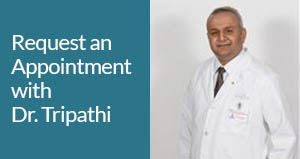CentraState Medical Center now performs fenestrated endovascular aortic repair (FEVAR), the latest treatment for complex aneurysms in the aorta located at or below the kidneys. CentraState vascular surgeon, Tushar Tripathi, MD, is currently the only physician in Monmouth and Ocean counties that performs FEVAR.
An abdominal aortic aneurysm (AAA) is a weak, bulging area in the aorta, the body’s largest artery that carries blood from the heart to the rest of the body. Rupture is the biggest threat posed by an aneurysm and this results in death in approximately 75% of the patients. According to the Centers for Disease Control (CDC), nearly 10,000 deaths in 2014 were caused by aortic aneurysm.
Unfortunately, patients with aortic aneurysms often don’t have any symptoms. While the incidence of aneurysm is more common in men and patients over the age 60, additional risk factors include family history of aneurysms, atherosclerosis (hardened arteries), high blood pressure, and smoking. Patients that experience a throbbing feeling in the stomach or deep pain in the lower back or side of abdomen or have a family history of aneurysm should consult with their physician about their risk. In addition to a complete medical history and physical exam, diagnostic procedures including computed tomography (CT or CAT) scan, MRI, ultrasound and angiogram are used to diagnose aneurysm.
“Minimally invasive endovascular repair (EVAR) of an aneurysm involves inserting a stent graft (a synthetic tube-like device) directly into the aneurysm. A stent graft is a steel or nitinol reinforced fabric that is used to reline the aneurysm so that the force of each heartbeat is absorbed by the stent graft rather than the weakened artery. Most patients wind up with two, small Band-Aids over a quarter inch scar” says Tushar Tripathi, MD, a board-certified surgeon specializing in vascular and endovascular surgery. “However, for about 10 percent of patients with AAA, the aneurysm is too close to the arteries that branch off to the kidneys for traditional repair to work. The only option for these patients, until recently, was major abdominal surgery or no surgery at all.”
FEVAR, uses a fenestrated endograft—a graft that has openings, or holes, or fenestrations that align with the arteries branching off of the aorta through which smaller stent grafts are connected to the aortic branches, allowing continuous blood flow to the kidneys, liver and intestines. The fenestrated stent graft is custom made to the precise size of the individual patient’s aorta so the openings for the renal (kidney) arteries are in just the right place to preserve blood flow to the kidneys.
“The graft is inserted into the femoral artery through an incision in the groin and then guided via fluoroscopy into the aneurysm,” states Tripathi. “The fenestration holes are then positioned over the openings of the branch vessels such as the renal arteries so that the blood flow continues to these vital vessels while the graft is secured in place inside the aneurysm. Once secured, blood can flow through the diseased area without putting any pressure on the aneurysm— preventing further growth and possible rupture of the aneurysm. FEVAR offers a number of benefits over traditional open surgery, including shorter hospital stays, fewer complications and risks, and faster recovery times.”
For more information about fenestrated endovascular aortic aneurysm repair (FEVAR) performed by Dr. Tripathi, or for a complete list of CentraState physicians that perform other endovascular interventions at CentraState’s Endovascular Lab, use our physician finder or call 866-CENTRA7.
CentraState Healthcare System is a nonprofit community health organization consisting of an acute-care hospital, a health and wellness campus, three senior living communities, a Family Medicine Residency Program, and a charitable foundation. CentraState’s teaching program is sponsored by Rutgers Robert Wood Johnson Medical School.



